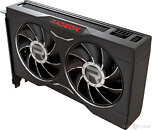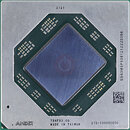T0@st
News Editor
- Joined
- Mar 7, 2023
- Messages
- 2,780 (3.68/day)
- Location
- South East, UK
| System Name | The TPU Typewriter |
|---|---|
| Processor | AMD Ryzen 5 5600 (non-X) |
| Motherboard | GIGABYTE B550M DS3H Micro ATX |
| Cooling | DeepCool AS500 |
| Memory | Kingston Fury Renegade RGB 32 GB (2 x 16 GB) DDR4-3600 CL16 |
| Video Card(s) | PowerColor Radeon RX 7800 XT 16 GB Hellhound OC |
| Storage | Samsung 980 Pro 1 TB M.2-2280 PCIe 4.0 X4 NVME SSD |
| Display(s) | Lenovo Legion Y27q-20 27" QHD IPS monitor |
| Case | GameMax Spark M-ATX (re-badged Jonsbo D30) |
| Audio Device(s) | FiiO K7 Desktop DAC/Amp + Philips Fidelio X3 headphones, or ARTTI T10 Planar IEMs |
| Power Supply | ADATA XPG CORE Reactor 650 W 80+ Gold ATX |
| Mouse | Roccat Kone Pro Air |
| Keyboard | Cooler Master MasterKeys Pro L |
| Software | Windows 10 64-bit Home Edition |
ITHome has picked up on interesting retail activity in China, where AMD Radeon RX 6650 XT graphics cards are deeply discounted. This seems to correspond to a possible discontinuation of Team Red's Navi 23 XT GPU—a Board Channel source stated: "AMD factory has stopped production of a certain GPU. At the present time, shipments from all AIB brands have stopped with inventory being cleared. AMD has stopped production for the Radeon RX 6650 XT, and nearly all brands will have their inventory cleared by the end of September." Board partners in China appear to running sales promotions, with cards reduced from an original MSRP of 3099 RMB ($425) down to as low as 1739 RMB (~$240), although these adjusted prices are mostly hovering around the 2000 RMB (~$275) mark.
AMD recently declared that its Radeon RX 7000 desktop lineup is now complete, following the unveiling of mid-range RX 7800 XT and RX 7700 XT cards at last week's Gamescom trade fair in Cologne, Germany. Their low-to-mid tier Radeon RX 7600 card, based on the Navi 33 XL GPU, is the sole successor to multiple RDNA 2 predecessors (RX 6600, 6600 XT & 6650 XT). AMD and its board partners are likely prioritizing larger scale RDNA 3 production, so the latest batch of GPU industry insider information is not all that surprising. Tom's Hardware points out that: "there is hardly any point for AMD to continue production of Navi 23. The company's RDNA 3-based Navi 33 GPU integrates 13.3 billion transistors, has 2048 SPs, and performs better than its direct predecessor. Meanwhile, it has a smaller die size (204 mm² vs 237 mm²) and is made on TSMC's N6 process technology (as opposed to N7 in the case of Navi 23), so it may well be cheaper to produce."




View at TechPowerUp Main Site | Source
AMD recently declared that its Radeon RX 7000 desktop lineup is now complete, following the unveiling of mid-range RX 7800 XT and RX 7700 XT cards at last week's Gamescom trade fair in Cologne, Germany. Their low-to-mid tier Radeon RX 7600 card, based on the Navi 33 XL GPU, is the sole successor to multiple RDNA 2 predecessors (RX 6600, 6600 XT & 6650 XT). AMD and its board partners are likely prioritizing larger scale RDNA 3 production, so the latest batch of GPU industry insider information is not all that surprising. Tom's Hardware points out that: "there is hardly any point for AMD to continue production of Navi 23. The company's RDNA 3-based Navi 33 GPU integrates 13.3 billion transistors, has 2048 SPs, and performs better than its direct predecessor. Meanwhile, it has a smaller die size (204 mm² vs 237 mm²) and is made on TSMC's N6 process technology (as opposed to N7 in the case of Navi 23), so it may well be cheaper to produce."




View at TechPowerUp Main Site | Source






